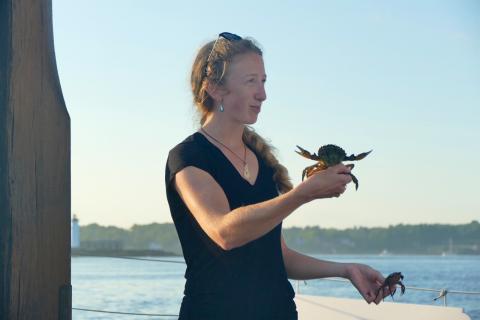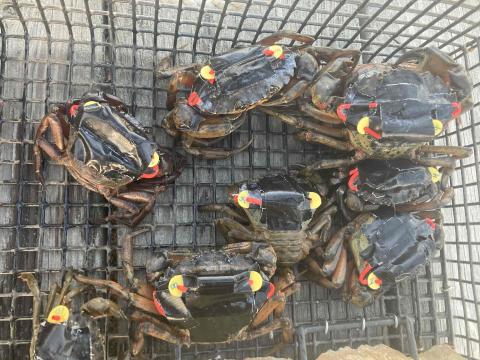Graduate Student Feature: Green Crab Tracking Backpacks

Emily Burke gives a talk about green crab movement ecology aboard the sailing vessel PISCATAQUA in Portsmouth Harbor as part of the Gundalow Company's speaker series. PHOTO: BENJAMIN GUTZLER.
What usually gets people excited about Emily Burke’s research is that she puts backpacks on crabs.
She keeps photos of green crabs with small ‘backpacks’ holding animal-tracking tags in a special folder on her phone for easy access. “It’s fun to be able to share this research at a moment’s notice, especially because green crabs have had a growing presence in the Gulf of Maine over the past decade.”
Burke’s project is describing the meter-scale movement ecology of green crabs using acoustic telemetry with Nathan Furey at the University of New Hampshire and Jason Goldstein at the Wells National Estuarine Research Reserve. This acoustic telemetry research is one part of a Saltonstall-Kennedy Grant exploring the feasibility of a pilot green crab fishery in New England, which also includes research objectives led by Gabriela Bradt (New Hampshire Sea Grant) and Steven Jury (St. Joseph’s College).
Green crabs are an invasive species of crustacean, originally from Europe, brought over by human activity. Since introduction over 150 years ago, they’ve established huge populations along most of the East Coast of the United States. Here in the Gulf of Maine, they threaten local shellfish industries – the crabs devour oysters, soft-shell clams, and mussels. They upset the balance and diversity of local ecosystems and displace native crabs.
Burke is interested in a specific part of the green crab life cycle that could help managers control populations of these prolific crabs – the egg-bearing females. A single female green crab holds hundreds of thousands of eggs, part of the reason these crabs are such successful invaders. If managers knew where to find these females, they could remove the crabs before the next generation can make it into our waters.
That’s where the backpacks come in. Each little backpack holds an acoustic tag, emitting sonic pings picked up by a network of underwater microphones around the bay. Researchers can then triangulate the location of the crabs based on which microphone hears a tag’s unique ping.
New Hampshire Sea Grant provided additional funding through the Graduate Research Fellowship to augment the project’s tracking program, which was slated to track 30 green crabs in the Webhannet estuary in Wells, Maine. The additional tags were used to track egg bearing females to understand how their behavior might differ from other crabs.

Green crabs with acoustic telemetry tags ready for release into the Webhannet River Estuary in Wells, Maine. PHOTO: EMILY BURKE.
“We’re curious where in the estuary green crabs spend the most time, if that changes seasonally, and if their movements depend on the sex, size, or egg-stage of the crab,” said Burke. This information, especially data on egg-bearing crabs, could then be used the same way that fisheries like lobster protect egg bearing females to maintain populations, except in the opposite way. “How can we use movement data to help manage an invasive population?” said Burke.
The data from the backpacks shows movement of crabs throughout the Webhannet estuary, whose wide variety of habitat types makes it excellent for study, providing data that could be applied to other estuaries along the East Coast.
Burke came to study green crabs because of her interest in the marine ecology, a theme she started in her undergraduate work at Harvard’s Giribet Lab researching the biogeography and genetics of marine invertebrates and continued at Friday Harbor Labs at the University of Washington studying the diets of forage fish. “I have really enjoyed the process of learning how these ecosystems function, the details of how they're connected, and what we can learn from them,” Burke said.
Green crabs are remarkable in their ability to tease apart these connections, according to Burke. Rather than building connections like a beaver or an otter, ecosystem engineers and keystone species, as invaders the green crabs dismantle ecosystems by breaking or interrupting links between species and their habitat.
Burke sees managing egg-bearing females as one option that communities dealing with green crabs may use to try to control invasive populations, and she’s hopeful it’ll become part of an array of tools they can employ alongside the emerging fishery for green crabs.
“Every area, each region is going to have different priorities. Some might prioritize having a diversified seafood economy and supporting an artisanal green crab fishery, others might focus on controlling the impacts of green crabs through targeted trapping efforts,” Burke explained. “Presenting a suite of management options based on recent research findings and the life history of the animal, I think, is a great way to move forward.”
Learn more about our graduate fellowships in research, policy, and more.